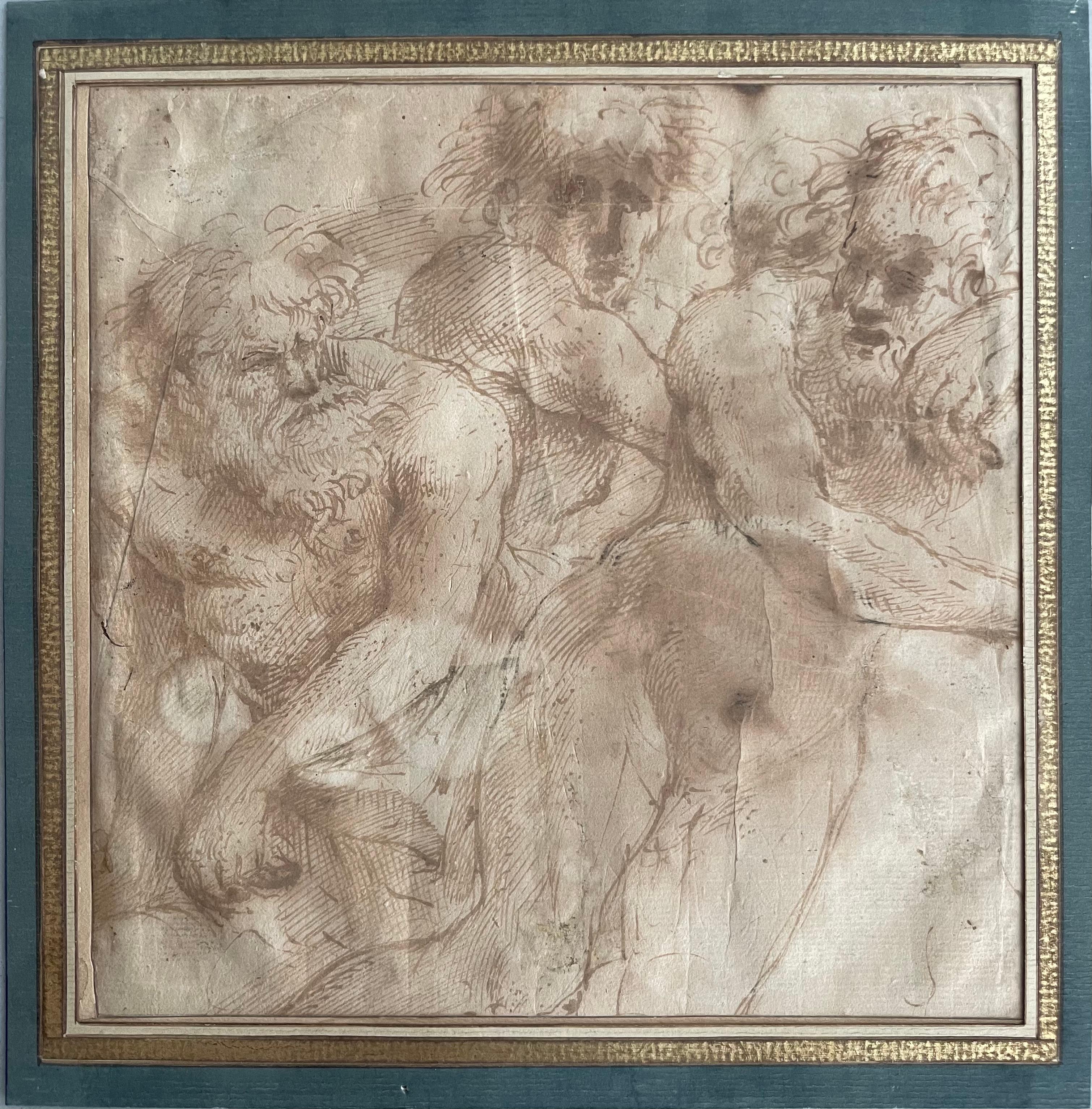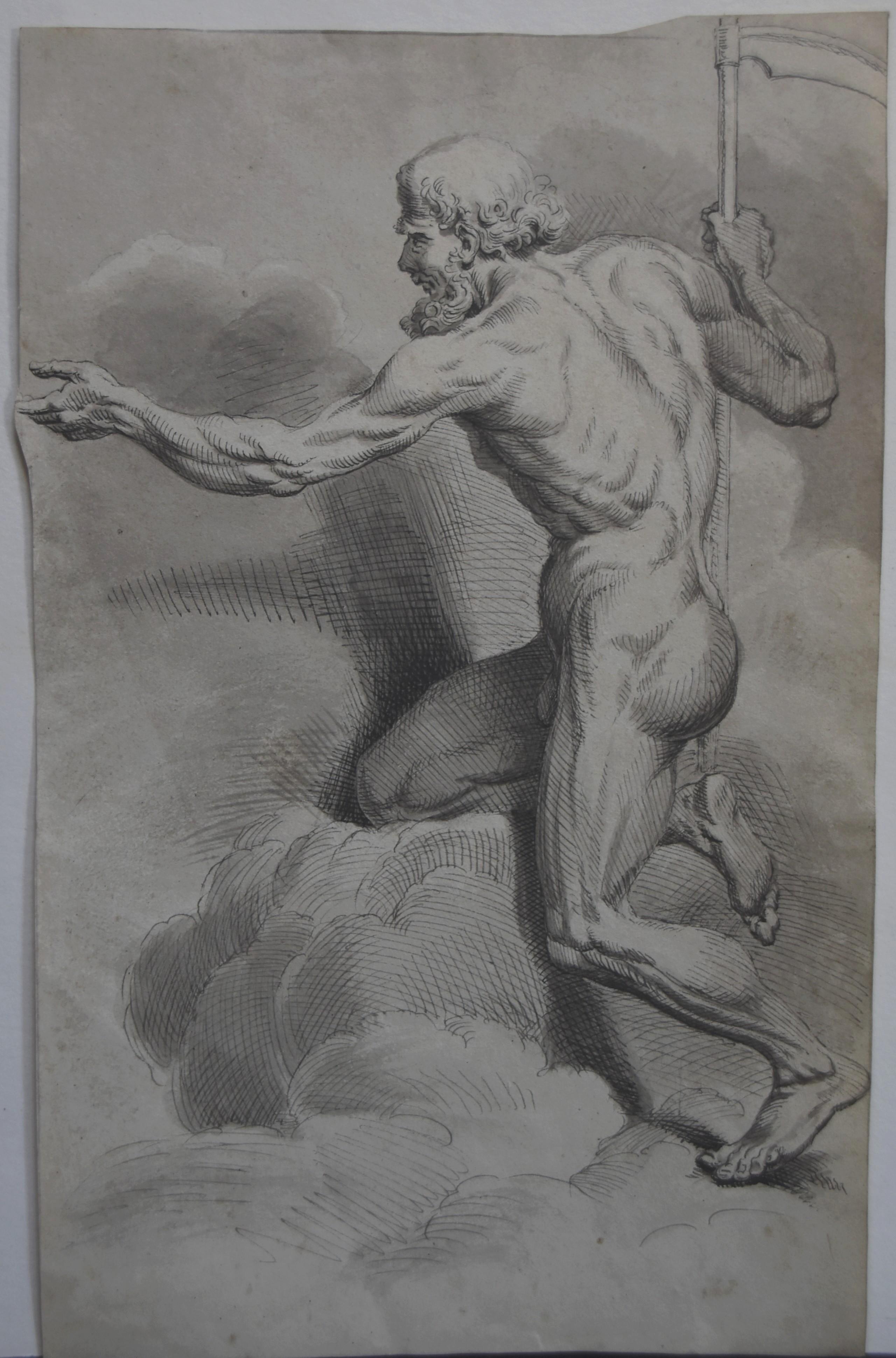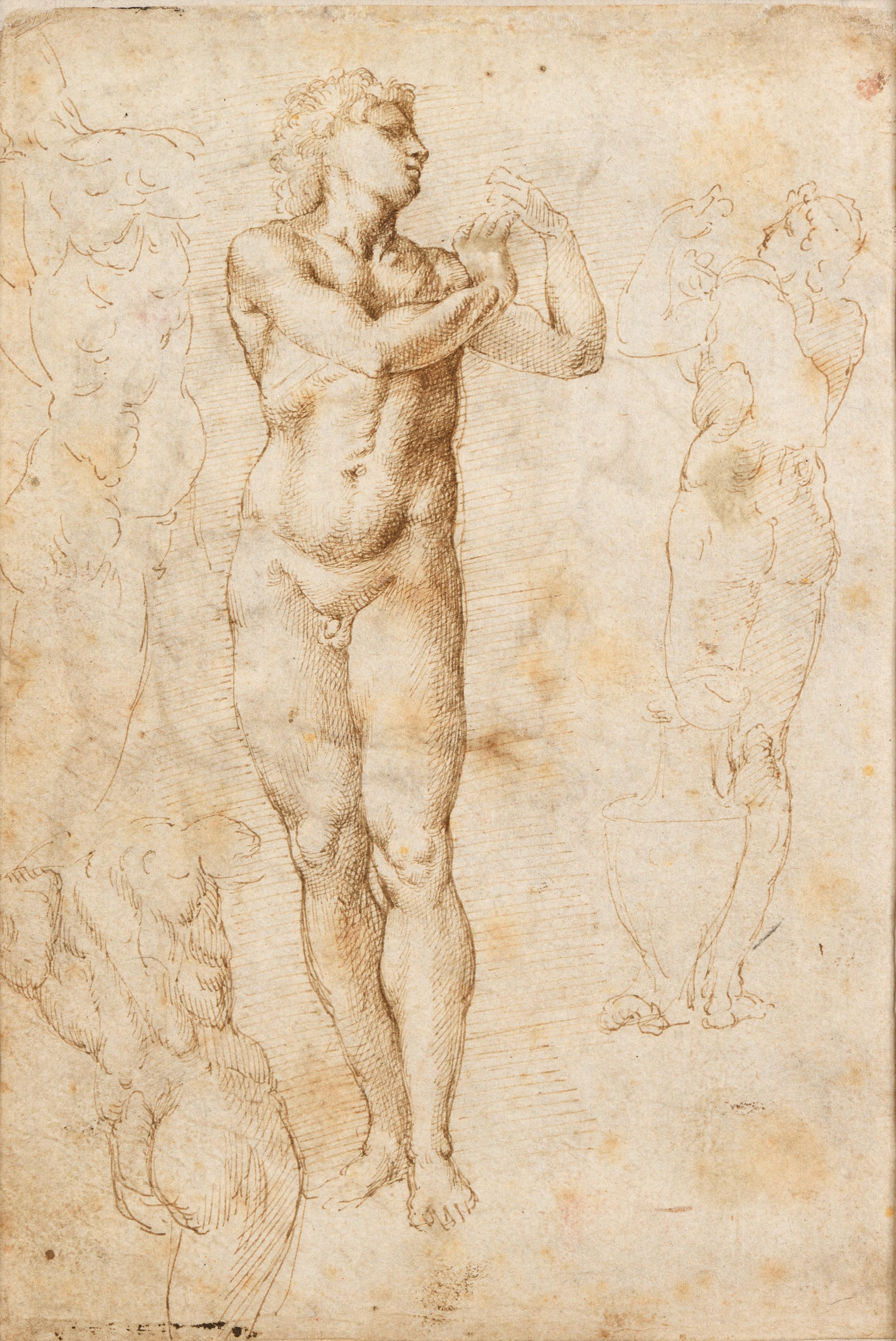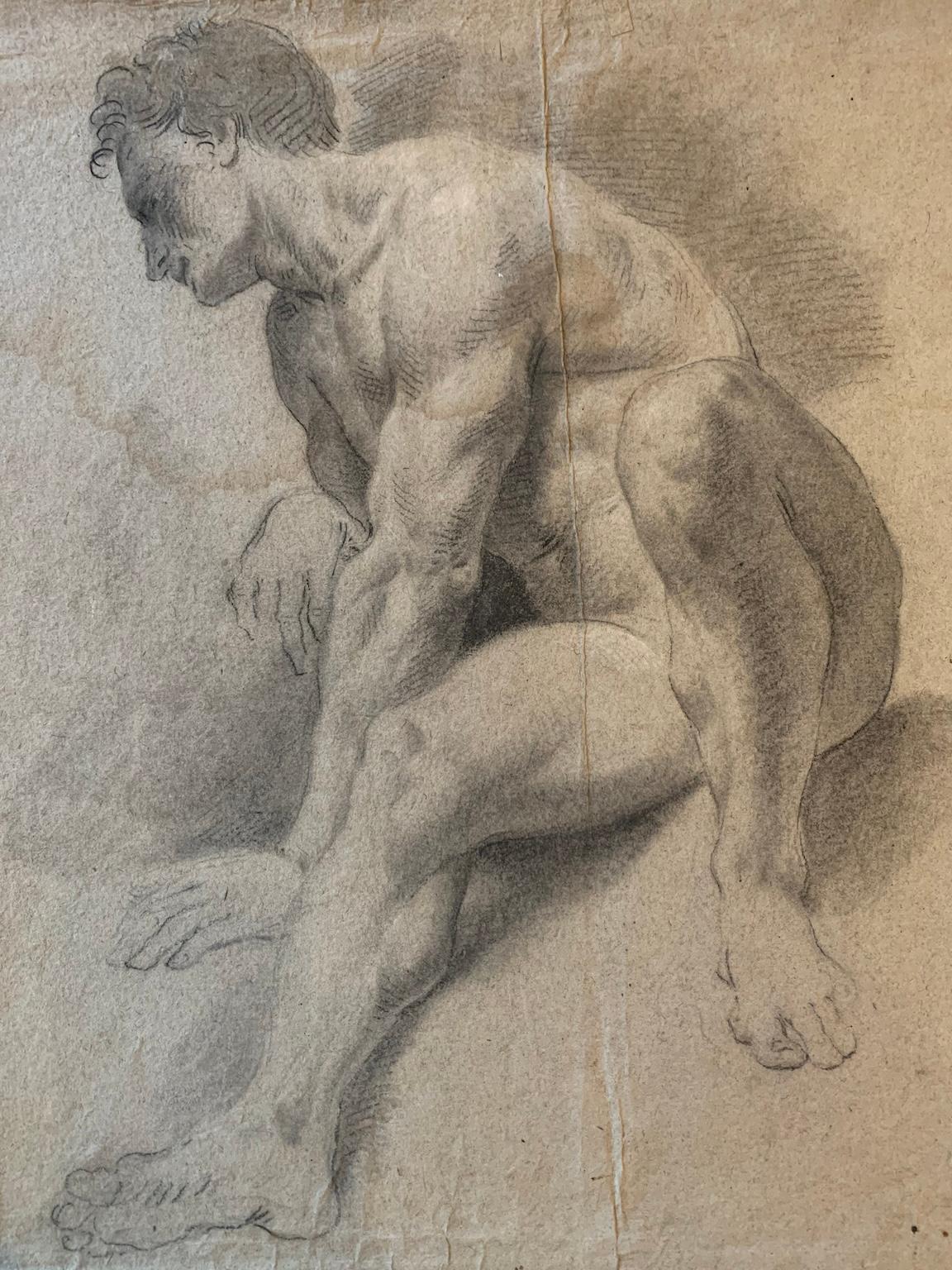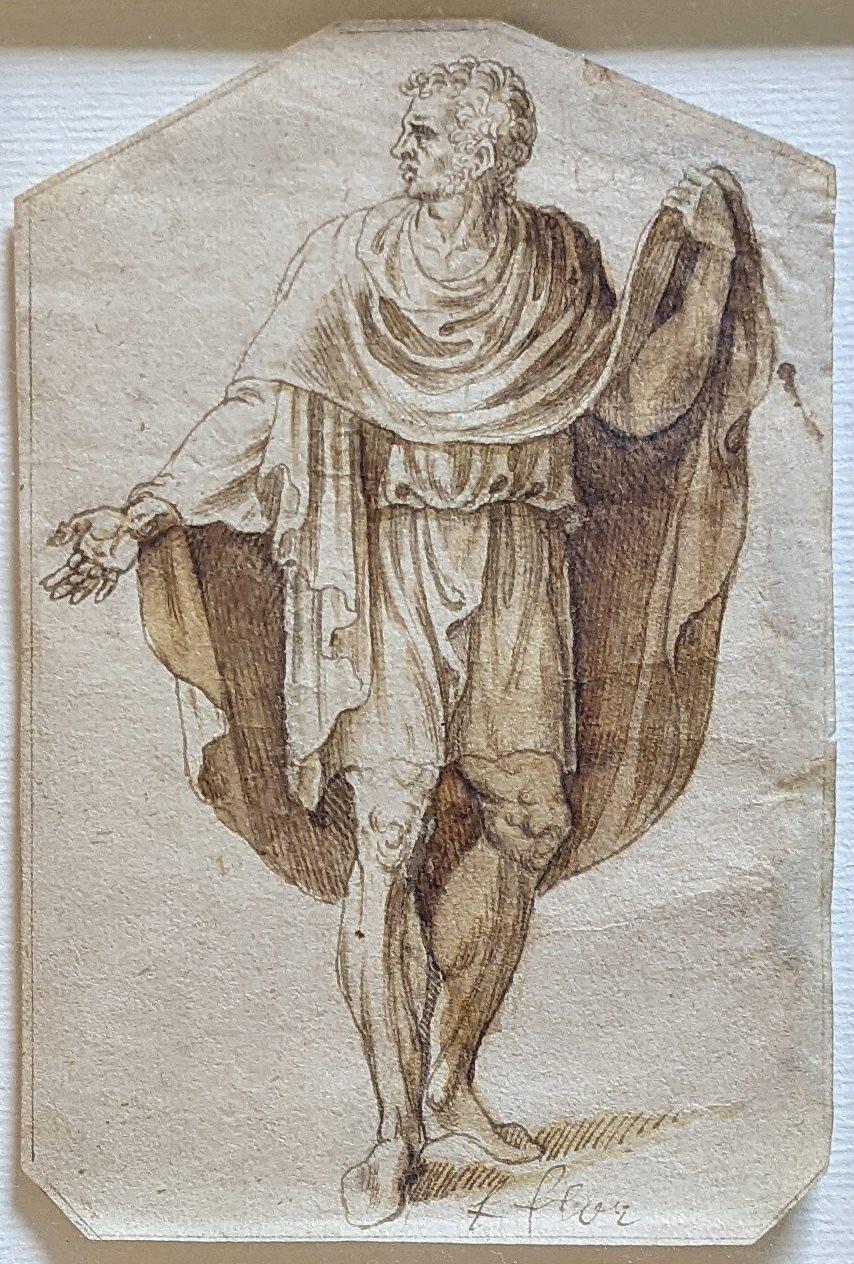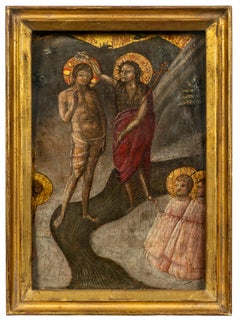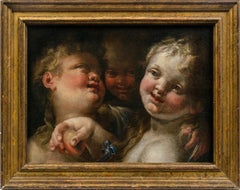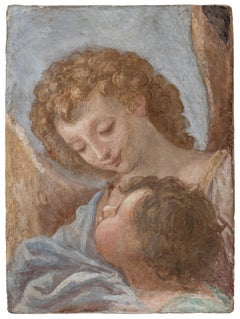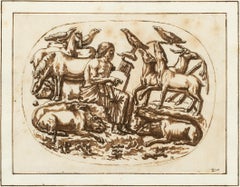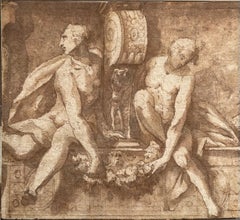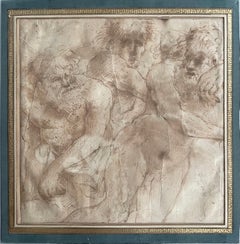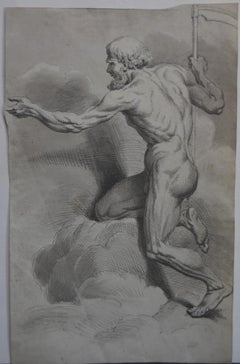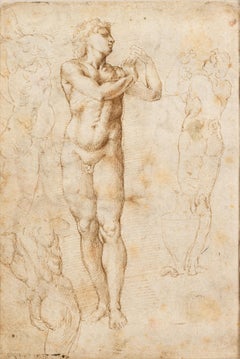Items Similar to Study after Michelangelo’s “The Last Judgment”
Want more images or videos?
Request additional images or videos from the seller
1 of 5
Study after Michelangelo’s “The Last Judgment”circa 1600
circa 1600
$40,000
£30,186.90
€34,559.44
CA$56,413.26
A$61,934.73
CHF 32,311.48
MX$749,496.41
NOK 404,974.23
SEK 381,592.20
DKK 257,976.97
About the Item
Italian School, 16th Century
Provenance:
Private Collection, New York
This intriguing drawing is a study by an anonymous 16th-century Italian artist after a vignette in Michelangelo’s fresco of The Last Judgement in the Sistine Chapel. The altar wall of the Sistine Chapel was already richly decorated when Pope Clement VII commissioned Michelangelo to paint his Last Judgment, replacing Perugino’s frescoed altarpiece of the Assumption of the Virgin and other works. Michelangelo’s colossal work, which depicts the physical power of nude bodies paired with the spiritual power of Christ to either damn or save, made a huge impact in Rome after its unveiling in 1536. It was engraved shortly thereafter by Giorgio Ghisi, which helped quickly circulate the imagery beyond the borders of Rome, making it accessible to artists both near and far. Artists flocked to the Sistine Chapel to learn from Michelangelo’s remarkable paintings, and the number of drawings made after the Last Judgment, many of which similarly concentrate on small groups of figures, shows the profound effect that Michelangelo’s fresco had on the next generations of artists active in Italy.
The present drawing is based on the lower left section of the fresco, where the souls of the dead are being raised up by angels (Fig. 1). The artist has here focused in on two angels battling a demon over the fate of a soul. The human figure, who is shown upside down, is being lifted upwards by the two angels. The figure’s legs are draped over the shoulders of the angel in green, who peers out at us from between the human’s knees and presses his foot into the head of the demon below, using it as leverage. The angel above works in concert with his partner below to tear the soul away from the grasp of the horned demon, who glances at us with a mischievous look while tugging at the soul’s hair, causing him to scream out in pain.
The faithful reproduction of the fresco’s colors and minor details in our drawing demonstrates that its author had direct knowledge of Michelangelo’s Last Judgment and likely executed the drawing in front of it. The fact that Daniele da Volterra was tasked with covering the nudity of the figures in the fresco in 1564 does not help us with dating this sheet, as the unclothed bodies in the lower left segment were left uncovered during both his and subsequent campaigns to sanitize the painting. However, it appears to be drawn by a roughly contemporary hand.
This section of the fresco was frequently copied by artists. Not only was it the most clearly visible and easily studied given its proximity to the ground, but also the compositional arrangement of the figures in this area are particularly dynamic and inventive, undoubtedly exciting Michelangelo’s viewers and fellow artists. Two drawings by another anonymous 16th-century Italian draughtsman after this part of the fresco, showing the neighboring figural group, are in the Royal Collection in Windsor. The passage of the Last Judgment depicted here was also copied by Peter Paul Rubens during his stay in Rome from 1601-1602. Additionally, Federico Zuccaro made a drawing of his brother, Taddeo, shown drawing a copy after this same section of the fresco in 1595 (Fig. 2), which helps us to envision how our draughtsman would have looked standing at work before the imposing fresco.
- Creation Year:circa 1600
- Dimensions:Height: 16.25 in (41.28 cm)Width: 10.625 in (26.99 cm)
- Medium:
- Movement & Style:
- After:Michelangelo Buonarroti (1475 - 1564, Italian)
- Period:
- Condition:
- Gallery Location:New York, NY
- Reference Number:1stDibs: LU1026198112
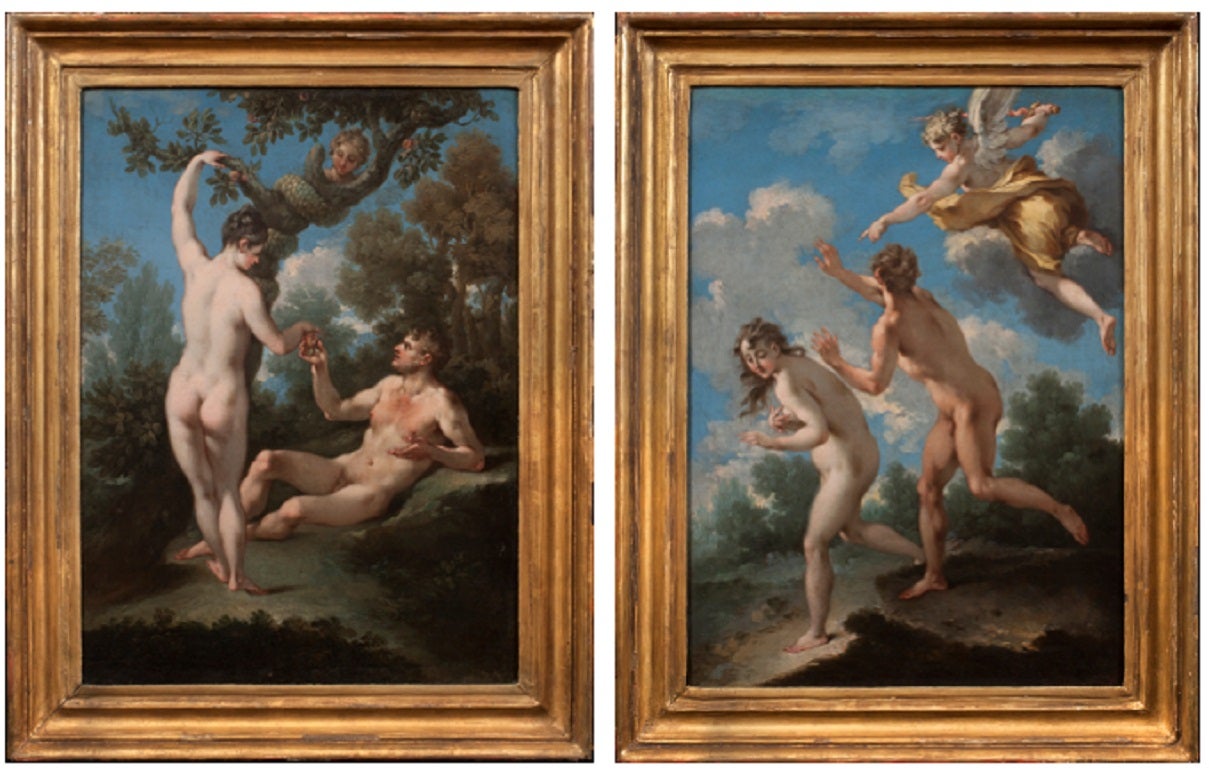
About the Seller
5.0
Recognized Seller
These prestigious sellers are industry leaders and represent the highest echelon for item quality and design.
Established in 1997
1stDibs seller since 2012
22 sales on 1stDibs
Typical response time: 20 hours
- ShippingRetrieving quote...Shipping from: New York, NY
- Return Policy
Authenticity Guarantee
In the unlikely event there’s an issue with an item’s authenticity, contact us within 1 year for a full refund. DetailsMoney-Back Guarantee
If your item is not as described, is damaged in transit, or does not arrive, contact us within 7 days for a full refund. Details24-Hour Cancellation
You have a 24-hour grace period in which to reconsider your purchase, with no questions asked.Vetted Professional Sellers
Our world-class sellers must adhere to strict standards for service and quality, maintaining the integrity of our listings.Price-Match Guarantee
If you find that a seller listed the same item for a lower price elsewhere, we’ll match it.Trusted Global Delivery
Our best-in-class carrier network provides specialized shipping options worldwide, including custom delivery.More From This Seller
View AllBaptism of Christ
Located in New York, NY
Provenance:
Achillito Chiesa, Milan
Luigi Albrighi, Florence, by 1 July 1955
with Marcello and Carlo Sestieri, Rome, 1969
Private Collection, Connecticut
Exhibited:
Mount Holyoke College Art Museum, South Hadley, Massachusetts (on loan, 2012)
Literature:
Carlo Volpe, “Alcune restituzioni al Maestro dei Santi Quirico e Giulitta,” in Quaderni di Emblema 2: Miscellanea di Bonsanti, Fahy, Francisci, Gardner, Mortari, Sestieri, Volpe, Zeri, Bergamo, 1973, pp. 19-20, fig. 18, as by the Master of Saints Quiricus and Julitta (now identified as Borghese di Piero).
This fine predella panel depicting the Baptism...
Category
15th Century and Earlier Old Masters Figurative Paintings
Materials
Tempera, Wood Panel
Three Angels
By Domenico Piola the Elder
Located in New York, NY
Provenance:
Robert L. and Bertina Suida Manning, New York, until 1996
Private Collection, USA
One of the leading artists in Genoa during the second half of the seventeenth century, Domenico Piola came from a successful family of artists, renowned for their many illusionistic ceiling programs throughout Genoese churches and palaces. A prolific draughtsman and painter, Domenico oversaw an extremely productive studio. In addition to his collaborations with numerous other artists, Domenico also provided many designs for book illustrations and prints that circulated throughout Europe, earning him international exposure and high acclaim in his own day.
As Dr. Anna Orlando has indicated (written communication), the present work is an early work by Piola, datable from the late 1640s. At this time the young artist came strongly under the influence of Castiglione and Valerio Castello, while admiring the works of Giulio Cesare Procaccini. Piola’s works from this period are exuberant and fluid, and the artist’s love of portraying children is evident from the angels and putti that populate both his altarpieces and more intimate paintings.
The present work depicts three angels...
Category
17th Century Baroque Figurative Paintings
Materials
Canvas, Oil
A Guardian Angel and a Child
Located in New York, NY
Provenance:
Cornelius Vanderbilt, New York; by whom gifted in 1880 to:
The Metropolitan Museum of Art, New York (80.3.673); deaccessioned and sold:
Christie’s, New York, 12 June 19...
Category
17th Century Old Masters Portrait Paintings
Materials
Terracotta, Gesso
Orpheus and the Animals, A Study after an Ancient Bas-Relief
Located in New York, NY
Inscribed “55” and “218” in the lower right
Watermark: Heawood 1351
Laid down on historic Cassiano Del Pozzo mount
(Mount Type A, 531 x 402 mm)
Provenance:
Commissioned by Cassiano dal Pozzo (1588–1637) for his Museo Cartaceo (Paper Museum) and kept in the library of his palazzo, via dei Chiavari, Rome
Transferred with the entire dal Pozzo collection by fidecommesso to his younger brother, Carlo Antonio dal Pozzo (1606–1689); by descent to his second son:
Gabriele dal Pozzo (d. 1695); by descent to his wife:
Anna Teresa Benzoni and after her remarriage in 1697, the Marchesa Lancellotti de’ Ginnetti (d. 1736); by descent to their son:
Cosimo Antonio dal Pozzo (d. 1740); by whom sold with the Dal Pozzo library in 1703 to:
Pope Clement XI for the Vatican Library; by whom transferred as part of the Museo Cartaceo in January 1714 to his nephew:
Cardinal Alessandro Albani (1692–1779), Palazzo ‘alle Quattro Fontane’ in Rome; by whom sold in 1762 to:
James Adam, agent for the British Royal Librarian Richard Dalton (1715–1791)
King George III of England, Buckingham House
Among the sheets of the ‘Museo Cartaceo’ appropriated by Richard Dalton during a reorganization of the drawings, circa 1786-1788; his estate sale, Greenwood’s, London, 11-19 May 1791; where acquired by:
John MacGowan...
Category
16th Century Baroque Figurative Drawings and Watercolors
Materials
Paper, Ink, Pen
The Assumption of the Virgin
Located in New York, NY
Provenance:
Unidentified collector’s mark “D.G.R,” lower right (Lugt 757b)
Wilhelm Suida (1877–1959), New York; by descent to:
Robert L. and Bertina Suida Manning, New York, until 1996
Private Collection, USA
This impressive drawing of the Assumption of the Virgin is the work of the Genoese artist Giovanni Battista Paggi. The son of a nobleman, Paggi received a humanist education and was a self-taught artist. According to Paggi’s first biographer, Raffaele Soprani, it was only after encountering Luca...
Category
16th Century Old Masters Figurative Drawings and Watercolors
Materials
Paper, Ink, Pen
Rebecca at the Well
Located in New York, NY
Provenance:
Dr. James Henry Lancashire, Manchester-by-the-Sea, Massachusetts, by 1925; probably by descent to:
Private Collection, Cumberland Foreside, Maine, until 2018
This unpublished panel is a characteristic work of the Master of the Apollo and Daphne Legend, an anonymous Florentine painter in the circle of Bartolommeo di Giovanni, Domenico Ghirlandaio, and Sandro Botticelli. The artistic personality of the Master of the Apollo and Daphne Legend was independently recognized by Everett Fahy and Federico Zeri at roughly the same moment in time. Fahy originally dubbed this artist the Master of the Ryerson Panels but later adopted Zeri’s name for the artist, which derives from his eponymous works from the Samuel H. Kress collection (Figs. 1-2). Fahy posited that the artist was most likely a pupil of Ghirlandaio active from roughly 1480 to 1510, and that he may be identifiable with one of Ghirlandaio’s documented pupils to whom no works have been securely attributed, such as Niccolò Cieco, Jacopo dell’Indaco, or Baldino Baldinetti. The present painting was first attributed to this master by Everett Fahy in 1989, who became aware of its existence only after publishing his definitive studies on the artist.
The surviving body of work by the Master of the Apollo and Daphne Legend is largely composed of series of panels treating the same theme. In addition to the works illustrating the legend of Apollo and Daphne, there are also series on the themes of Susanna and the Elders and the story of Saint Joseph, among others. The subject of the present panel is drawn from Genesis 24, the story of Isaac. It is possible that our painting relates to another work by the artist depicting the Sacrifice of Isaac formerly in the collection of E. A. McGuire in Dublin, Ireland (Fig. 3), and that these two panels were originally part of a decorative scheme based on the story of Isaac.
Although the Master’s paintings of this type have traditionally been considered painted fronts of wedding chests, known as cassoni, the scale of these paintings and the fact that they are often part of a series indicates that they are more likely spalliera panels—paintings set into furniture or the wainscoting of a room. The biblical episode depicted in this painting centers on the theme of marriage, which suggests that this work was likely commissioned for the domestic interior of a newly married couple. The Master has transcribed into paint even the minute details of this Old Testament story, in which Abraham sends a servant to travel by camel to the land of his father and seek out a wife for his son Isaac. The servant is here shown at the well...
Category
15th Century and Earlier Old Masters Figurative Paintings
Materials
Oil, Tempera, Wood Panel
You May Also Like
Study for a fresco
Located in Paris, Île-de-France
Attributed to Francesco PENNI (1488 – 1528)
Study for a fresco
Pen and brown ink, brown wash heightened with white on prepared paper
14 x 12 cm
Unsigned
On the mount, handwriting ...
Category
16th Century Old Masters Interior Drawings and Watercolors
Materials
Ink
$11,967
Italian School, 16th Century, Study of figures
Located in Paris, Île-de-France
Italian School, 16th Century
Studies of Figures
Pen and ink on paper,
23 × 24 cm
Unsigned
A finely executed sheet presenting vigorous figure studies, drawn with assured pen strok...
Category
16th Century Old Masters Nude Drawings and Watercolors
Materials
Ink
French Neo classical school, Allegory of Time, original drawing
Located in Paris, FR
Neo classical school, France, end of the 18th Century
Allegory of Time,
Pen and black ink on paper, gray ink wash
30.5 x 19 cm
irregularly shaped
In g...
Category
1790s Old Masters Nude Drawings and Watercolors
Materials
India Ink
Studies of the Galli Statue and of an Ignudo
Located in Paris, Île-de-France
Florentine School, early 16th century
Studies of the Galli Statue and of an Ignudo
Pen and brown ink on laid paper
19.1 × 13 cm
Executed c. 1510–1520
Unsigned
This remarkable doub...
Category
16th Century Old Masters Nude Drawings and Watercolors
Materials
Ink
Academy of seated nude of 19th century Italian school
Located in Florence, IT
Seated male nude that falls fully within the academic "model from life" production of the early 19th century, as also seems confirmed by the "Titus-like" hairdo of the effigy.
The s...
Category
Early 19th Century Other Art Style Nude Drawings and Watercolors
Materials
Paper, Pencil
Study of a Man, Old Master Drawing, Figure, Roman Study, Lombard
Located in Greven, DE
Old Master Drawing by the Circle of Lambert Lombard. Drawing/ Study of a Man in Renaissance Style, later signed "F. Floris".
Study of a Man
Lombard li...
Category
16th Century Renaissance Figurative Drawings and Watercolors
Materials
Handmade Paper
$2,890 Sale Price
20% Off

